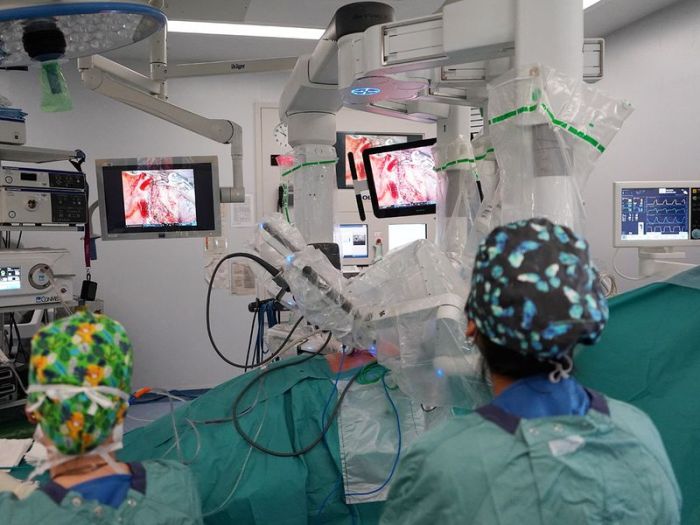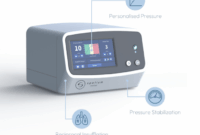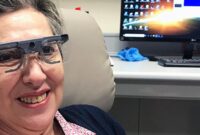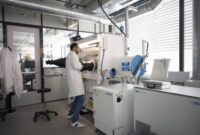Spanish surgeons perform worlds first fully robotic lung transplant – Spanish surgeons have made history by performing the world’s first fully robotic lung transplant, marking a significant milestone in the field of organ transplantation. This groundbreaking procedure, carried out at the University Hospital of La Paz in Madrid, has opened up new possibilities for patients in need of lung transplants, offering potential benefits like faster recovery times, reduced complications, and improved surgical precision.
The surgery involved a highly skilled team of surgeons, utilizing state-of-the-art robotic technology to meticulously remove the donor lung and implant it into the recipient. The robotic system allowed for greater dexterity and control, minimizing invasive procedures and reducing the risk of human error.
This innovative approach has the potential to revolutionize the way lung transplants are performed globally.
The Significance of the First Fully Robotic Lung Transplant
The recent accomplishment of a fully robotic lung transplant by Spanish surgeons marks a significant milestone in the history of organ transplantation. This groundbreaking procedure represents a culmination of decades of research and development in robotic surgery, pushing the boundaries of minimally invasive techniques and potentially revolutionizing the future of transplantation.
Historical Context and Advancements
Lung transplantation has been a life-saving procedure for patients with end-stage lung disease since the first successful transplant in 1963. Over the years, advancements in surgical techniques, immunosuppressive medications, and donor management have significantly improved the success rates and long-term outcomes of lung transplantation.
However, traditional open-chest surgery remains a complex and invasive procedure with inherent risks and limitations. The introduction of minimally invasive techniques, such as video-assisted thoracoscopic surgery (VATS), has significantly reduced the invasiveness of lung surgery. However, VATS still requires a surgeon to perform the procedure manually, limiting its precision and control.
The development of robotic surgery, with its ability to provide surgeons with enhanced dexterity, precision, and visualization, has opened up new possibilities for minimally invasive lung transplantation.
Potential Impact on Future Organ Transplantation
The success of the first fully robotic lung transplant has significant implications for the future of organ transplantation. Here are some potential impacts:
- Improved Surgical Outcomes:Robotic surgery offers enhanced precision and control, potentially leading to fewer complications, shorter recovery times, and improved long-term outcomes for transplant recipients.
- Increased Accessibility:Robotic surgery can be performed by skilled surgeons remotely, potentially expanding access to transplantation for patients in underserved areas or those with limited access to specialized centers.
- Minimally Invasive Approach:Robotic surgery minimizes the need for large incisions, reducing pain, scarring, and risk of infection, ultimately improving patient recovery and quality of life.
- Enhanced Training and Education:Robotic surgery platforms provide opportunities for surgeons to practice and refine their skills in a virtual environment, potentially improving the training and education of future transplant surgeons.
Ethical Considerations, Spanish surgeons perform worlds first fully robotic lung transplant
The use of robotic surgery in transplantation raises important ethical considerations:
- Access and Equity:Ensuring equitable access to this technology for all patients, regardless of their socioeconomic status or geographic location, is crucial.
- Surgeon Training and Expertise:The training and expertise required to perform robotic surgery need to be carefully evaluated and standardized to ensure patient safety and optimal outcomes.
- Cost-Effectiveness:The cost of robotic surgery equipment and procedures needs to be considered in relation to its potential benefits and compared to traditional surgical methods.
- Patient Autonomy and Informed Consent:Patients need to be fully informed about the risks and benefits of robotic surgery and have the autonomy to make informed decisions about their care.
The Surgical Procedure and Team
The first fully robotic lung transplant, performed by Spanish surgeons, represents a significant advancement in minimally invasive surgery. The procedure involved a highly skilled surgical team and innovative robotic technology, showcasing the potential for enhanced precision and patient recovery.
The Surgical Steps
The robotic lung transplant involved a meticulous sequence of steps, carefully executed by the surgical team.
Check sorry apple user youre just a plain boring sheep now to inspect complete evaluations and testimonials from users.
- Donor Lung Preparation:The donor lung was carefully harvested and prepared for transplantation. This step involved meticulous examination and preservation to ensure the lung’s suitability for the recipient.
- Recipient Preparation:The recipient underwent a thorough evaluation to determine their suitability for the transplant and prepare them for the procedure. This included imaging studies and assessments of their overall health.
- Robotic Surgery:The robotic system was used to perform the delicate surgery, allowing for precise movements and minimal invasiveness. The surgeons manipulated the robotic arms, equipped with specialized instruments, to remove the recipient’s diseased lung and implant the donor lung.
- Post-Operative Care:Following the surgery, the patient underwent intensive post-operative care to monitor their recovery and manage any complications. This included medication, physiotherapy, and close monitoring of their lung function.
The Surgical Team
The success of the robotic lung transplant relied on the expertise and coordination of a multidisciplinary team.
- Surgeons:The surgeons played a pivotal role in planning and executing the procedure. They used the robotic system to perform the delicate surgical steps, ensuring precision and minimizing invasiveness.
- Anesthesiologists:The anesthesiologists monitored the patient’s vital signs throughout the procedure, ensuring their safety and comfort. They administered anesthesia and managed pain during and after the surgery.
- Nurses:The nurses provided crucial support to the surgical team, assisting with patient care and monitoring their recovery. They also played a vital role in coordinating communication and ensuring the smooth operation of the procedure.
- Respiratory Therapists:Respiratory therapists were essential in managing the patient’s breathing and lung function both before, during, and after the surgery. They provided specialized respiratory care and ensured the patient’s airways were clear and functioning properly.
- Other Specialists:The team also included other specialists, such as radiologists, pathologists, and infectious disease specialists, who provided essential expertise in different aspects of the transplant process.
Robotic Technology
The robotic system used in the lung transplant procedure is a highly sophisticated technology that allows surgeons to perform complex surgeries with greater precision and control.
The robotic system used in the procedure allowed surgeons to perform complex surgical tasks with greater precision and control.
- Intuitive Surgical’s da Vinci System:The da Vinci system is a widely used robotic platform for minimally invasive surgery. It consists of a surgeon’s console, robotic arms with specialized instruments, and a high-definition 3D camera.
- 3D Visualization:The da Vinci system provides surgeons with a magnified, 3D view of the surgical field, enhancing their ability to see intricate details and perform delicate maneuvers. This allows for greater precision and reduced risk of damage to surrounding tissues.
- Precise Instrument Movement:The robotic arms translate the surgeon’s hand movements with greater precision and control than traditional laparoscopic instruments. This allows for more delicate and accurate surgical steps, potentially leading to improved outcomes and reduced complications.
Comparison to Traditional Lung Transplant Methods
The robotic lung transplant offers several advantages over traditional open surgery methods.
- Minimally Invasive:Robotic surgery involves smaller incisions, resulting in less pain, faster recovery, and a shorter hospital stay compared to traditional open surgery.
- Enhanced Precision:The robotic system allows for greater precision and control, minimizing damage to surrounding tissues and potentially reducing complications. This can lead to improved surgical outcomes and faster recovery.
- Improved Patient Experience:The minimally invasive nature of robotic surgery can lead to less pain, discomfort, and scarring for the patient. This can contribute to a more positive patient experience and faster return to daily activities.
Patient Selection and Post-Operative Care
The groundbreaking achievement of the world’s first fully robotic lung transplant raises crucial questions regarding patient selection and the comprehensive care required post-surgery. The success of this procedure hinges on a meticulous selection process and a robust post-operative care plan to ensure the patient’s well-being and optimize the chances of a successful outcome.
Patient Selection Criteria
Selecting suitable candidates for this complex procedure is paramount. The criteria for patient selection are stringent, focusing on a combination of medical factors and lifestyle considerations. These criteria aim to ensure that the patient is a good candidate for surgery and has the best chance of a successful outcome.
- Severity of Lung Disease:The patient must have a severe, end-stage lung disease that is unresponsive to conventional treatment options. This could include conditions like cystic fibrosis, pulmonary fibrosis, or chronic obstructive pulmonary disease (COPD).
- Overall Health Status:The patient must be in relatively good overall health, with no significant comorbidities that could complicate the surgery or recovery. This includes factors like heart function, kidney function, and blood pressure.
- Lifestyle and Commitment:The patient must be willing and able to adhere to a strict post-operative regimen, including medication adherence, physical therapy, and lifestyle modifications. This includes quitting smoking and maintaining a healthy diet and exercise routine.
- Psychological Evaluation:A comprehensive psychological evaluation is essential to assess the patient’s emotional preparedness for the procedure and their ability to cope with the challenges of post-operative recovery.
Post-Operative Care
The post-operative care for patients undergoing robotic lung transplantation is a critical aspect of the overall treatment plan. It involves a multidisciplinary approach to manage potential complications, optimize recovery, and ensure the patient’s long-term well-being.
- Intensive Care Monitoring:Immediately after surgery, patients are admitted to an intensive care unit (ICU) for close monitoring of vital signs, organ function, and potential complications. This includes regular blood tests, chest X-rays, and other diagnostic procedures to assess the patient’s recovery.
- Pain Management:Pain management is a crucial aspect of post-operative care. Pain medications, including analgesics and opioids, are administered to alleviate discomfort and promote healing.
- Anti-Rejection Medications:To prevent the body from rejecting the transplanted lung, patients receive a combination of immunosuppressive medications. These medications help to suppress the immune system and reduce the risk of rejection.
- Respiratory Therapy:Respiratory therapy plays a vital role in post-operative care. This involves techniques like deep breathing exercises, coughing, and incentive spirometry to help clear the lungs and prevent pneumonia.
- Physical Therapy:Physical therapy is crucial for regaining strength, mobility, and endurance. It involves a personalized program of exercises and activities tailored to the patient’s individual needs and progress.
- Nutritional Support:Adequate nutrition is essential for healing and recovery. Patients may receive intravenous fluids and nutritional supplements in the initial stages to ensure proper hydration and nutrient intake.
- Psychological Support:Psychological support is crucial for patients undergoing a major surgery like lung transplantation. This may involve counseling, support groups, and other resources to help patients cope with the emotional and psychological challenges of the recovery process.
Expected Recovery Timeline and Potential Complications
The recovery process after robotic lung transplantation is gradual and requires ongoing medical management. The expected timeline and potential complications vary depending on individual factors, including the patient’s overall health, the severity of their lung disease, and the complexity of the surgery.
- Hospital Stay:Patients typically spend several weeks in the hospital recovering from the surgery. The length of stay depends on the patient’s progress and the management of any complications.
- Rehabilitation:After discharge from the hospital, patients will continue their rehabilitation at home or in a specialized rehabilitation facility. This involves ongoing physical therapy, respiratory therapy, and medication management.
- Potential Complications:While robotic lung transplantation is a complex procedure, potential complications can arise. These may include infection, bleeding, rejection of the transplanted lung, and other organ dysfunction.
Future Implications and Research: Spanish Surgeons Perform Worlds First Fully Robotic Lung Transplant

This groundbreaking achievement opens doors to a future where robotic surgery plays a more prominent role in transplant procedures. The success of the first fully robotic lung transplant is a testament to the potential of this technology and inspires further research and development in the field.
Applications in Other Transplant Procedures
The success of robotic lung transplantation paves the way for exploring its application in other complex transplant procedures. The minimally invasive nature of robotic surgery, coupled with its precision and dexterity, makes it particularly suitable for delicate procedures involving organs like the heart, liver, and kidneys.
- Heart Transplantation:Robotic surgery could improve the accuracy and precision of heart transplant procedures, potentially reducing complications and improving patient outcomes. The robotic arms could assist in the intricate process of connecting blood vessels and ensuring optimal positioning of the donor heart.
- Liver Transplantation:Robotic surgery could be valuable in liver transplantation, particularly for complex cases involving partial liver transplants or grafts from living donors. The robotic instruments’ precision could facilitate delicate dissection and anastomosis of blood vessels and bile ducts.
- Kidney Transplantation:Robotic surgery could enhance the precision and minimally invasive nature of kidney transplant procedures. The robotic arms could assist in the intricate process of connecting the renal artery and vein, ensuring optimal blood flow to the transplanted kidney.
Global Impact and Collaboration
The successful completion of the world’s first fully robotic lung transplant has profound implications for global healthcare systems and the future of surgical procedures. This groundbreaking achievement signifies a significant leap forward in minimally invasive surgery, offering potential benefits to patients and healthcare providers worldwide.
This procedure has the potential to revolutionize lung transplantation, a complex and challenging surgical procedure. By leveraging the precision and dexterity of robotic technology, surgeons can now perform this life-saving operation with greater accuracy and control, potentially leading to faster recovery times and improved outcomes for patients.
International Collaboration in Robotic Surgery
The development of robotic surgery technology has been a collaborative effort involving researchers, engineers, and surgeons from across the globe. International partnerships have played a crucial role in advancing the field, sharing expertise, and accelerating the development of innovative surgical techniques.
The successful implementation of the fully robotic lung transplant is a testament to the power of international collaboration.
- The surgical team involved experts from Spain, the United States, and other countries, bringing together diverse perspectives and experience.
- The development of the robotic surgical system itself was a collaborative effort involving companies and research institutions from multiple countries.
- The sharing of knowledge and best practices through international conferences and publications has been instrumental in advancing robotic surgery technology.
Examples of Other Research Initiatives in Robotic Transplantation Worldwide
Several research initiatives are underway worldwide, exploring the potential of robotic surgery in various transplantation procedures. These initiatives aim to refine existing robotic systems, develop new surgical techniques, and expand the application of robotic surgery in transplantation.
- In the United States, researchers at the Cleveland Clinic are investigating the use of robotic surgery for kidney transplantation. The aim is to improve surgical precision and reduce the risk of complications associated with traditional open surgery.
- In Japan, researchers at the University of Tokyo are developing a robotic system specifically designed for liver transplantation. The system incorporates advanced imaging and navigation technology to enhance surgical accuracy and minimize damage to surrounding tissues.
- In Europe, the European Union is funding several research projects focused on developing robotic systems for organ transplantation. These projects involve collaborations between universities, hospitals, and technology companies across the continent.





